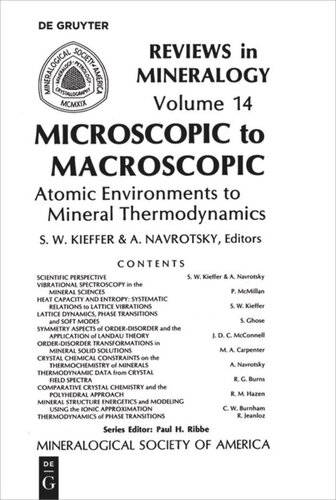

Most ebook files are in PDF format, so you can easily read them using various software such as Foxit Reader or directly on the Google Chrome browser.
Some ebook files are released by publishers in other formats such as .awz, .mobi, .epub, .fb2, etc. You may need to install specific software to read these formats on mobile/PC, such as Calibre.
Please read the tutorial at this link: https://ebookbell.com/faq
We offer FREE conversion to the popular formats you request; however, this may take some time. Therefore, right after payment, please email us, and we will try to provide the service as quickly as possible.
For some exceptional file formats or broken links (if any), please refrain from opening any disputes. Instead, email us first, and we will try to assist within a maximum of 6 hours.
EbookBell Team

4.8
34 reviewsVolume 14 of Reviews in Mineralogy covers a short course about the relations among the microscopic structure of minerals and their macroscopic thermodynamic properties. Understanding the micro-to-macro relations provides a rigorous theoretical foundation for formulation of energy relations. With such a foundation, measured parameters can be understood, and extrapolation and prediction of thermodynamic properties beyond the range of measurement can be done with more confidence than if only empirical relations are used.
The purpose of this course is to consider the microscopic factors that influence the free energy of minerals: atomic environments, bonding, and crystal structure. These factors influence the structural energy and the detailed nature of the lattice vibrations which are an important source of entropy and enthalpy at temperatures greater than 0 K. The same factors determine the relative energy of different phases, and thereby; the relative stability of different minerals. Configurational entropy terms arising from disorder also contribute to the energy and entropy. In transition metal compounds there are additional energy and entropy terms arising from the electronic configurations, leading to additional stabilizations, magnetic ordering, and, incidentally, color.
Organized by Sue Kieffer and Alex Navrotsky, the course was presented by the ten authors of this book on the campus of Washington College in Chestertown, Maryland. This was the second of MSA's short courses to be given in conjunction with meetings of the American Geophysical Union.